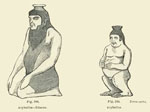Previous First Next
SALAMIS IN THE ISLAND OF CYPRUS.
BY ALEXANDER PALMA DI CESNOLÀ, F.S.A.,
page 121
 which a small portion of the liquid to be preserved was introduced into the hollow interior of the vessel is placed at the top of the head. It is not improbable that this vessel, and others of a similar character, were purely ornamental in character, and, like the chimney ornaments of the present day, never employed to contain anything. The excavations which I conducted at Kitium disclosed an aryballos (fig. 288) in form of a Silenus, with heart-shaped beard, kneeling, with the hands placed upon the thighs. The body is hollow, and the mouth is formed upon the top of the head of the figure. Another aryballos is in form of one of the misshapen Kerkopes, or thieves of Ephesus (fig. 289). The upper part of a human figure, clasping the hands over which a small portion of the liquid to be preserved was introduced into the hollow interior of the vessel is placed at the top of the head. It is not improbable that this vessel, and others of a similar character, were purely ornamental in character, and, like the chimney ornaments of the present day, never employed to contain anything. The excavations which I conducted at Kitium disclosed an aryballos (fig. 288) in form of a Silenus, with heart-shaped beard, kneeling, with the hands placed upon the thighs. The body is hollow, and the mouth is formed upon the top of the head of the figure. Another aryballos is in form of one of the misshapen Kerkopes, or thieves of Ephesus (fig. 289). The upper part of a human figure, clasping the hands over  the stomach, is united to the hind legs of an animal. These droll and thievish gnomes are reputed, according to the legend, to have robbed Hercules while he was sleeping. Some place the scene of their tricks at Thermopylae, others at Œchaliain Eubœa, or in Lydia. Both these types occur in tombs at Camirus in Rhodes, and specimens will be found, as the stomach, is united to the hind legs of an animal. These droll and thievish gnomes are reputed, according to the legend, to have robbed Hercules while he was sleeping. Some place the scene of their tricks at Thermopylae, others at Œchaliain Eubœa, or in Lydia. Both these types occur in tombs at Camirus in Rhodes, and specimens will be found, as  Mr. Newton kindlyinforms me, among the terra-cottas preserved in the British Museum. Other moulded vases, chiefly of the class designated as aryballi, take the shape of a goat reposing, with the head turned to the front (fig. 290); of a dog in a similar attitude (fig. 291); of a sheep, or she-goat (fig. 292). All these figures have the orifice, or neckof the vessel, placed in a small mouth fitted with a lip in the middle of the back of theanimal figure. They were found at Kitium, one of the most prolific, sites in the island of Cyprus with respect to archǽlogical discoveries. Mr. Newton kindlyinforms me, among the terra-cottas preserved in the British Museum. Other moulded vases, chiefly of the class designated as aryballi, take the shape of a goat reposing, with the head turned to the front (fig. 290); of a dog in a similar attitude (fig. 291); of a sheep, or she-goat (fig. 292). All these figures have the orifice, or neckof the vessel, placed in a small mouth fitted with a lip in the middle of the back of theanimal figure. They were found at Kitium, one of the most prolific, sites in the island of Cyprus with respect to archǽlogical discoveries.
Of the same class is a cock (fig. 293), having the mouth of the vessel placed in the same position as in the preceding objects. This also comes from Kitium, and the general
Previous First Next
|